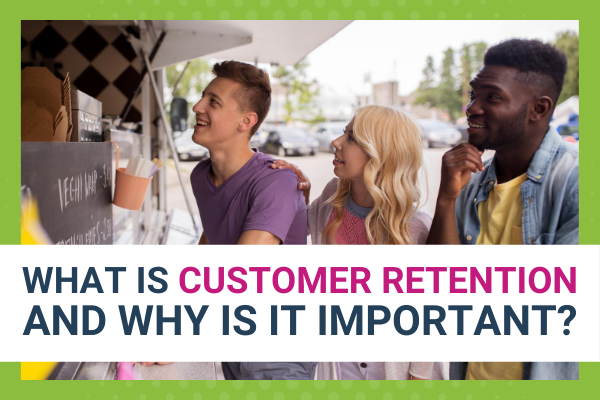When it comes to running a successful business, the emphasis should always be on your current customers. While attracting new customers is important, your existing customers are easier to engage, and they’re more likely to continue to spend money with your business into the future. The practice of encouraging repeat customers is known as customer retention.
As a business, you need more than just a marketing strategy. You need a plan for keeping existing customers excited, while also widening your reach to new customers. Being a customer-first business doesn’t start with the customers currently in your sales funnel. It starts with the customers you already have.
Despite this reality, only a reported 18% of businesses focus on customer retention. On the other hand, 44% of businesses instead focus on customer acquisition. While acquisition is important, it’s only one side of the story.
With that in mind, is customer retention really all it’s cracked up to be? After all, what’s the harm in focusing on new customers and attracting a wider audience? In this guide, we’ll share what customer retention is as well as why it’s essential for any business today. If you’re in the market for superfans—that is, highly-invested customers who rave about your business—you need to make customer retention a priority.
What is customer retention?
To start, what is customer retention? This is a buzzword that’s thrown around a lot, but what does it actually mean in practice? In simple words, customer retention is a brand’s ability to keep customers long-term. As a metric, it’s usually measured as the percentage of customers who made a repeat purchase over a specific period of time.
There are a few different ways to track customer retention, such as:
- Repeat purchases: The easiest way to see customer retention in action is through repeat purchases. When a customer continues to buy from a specific provider, they’re showing brand loyalty.
- Subscription: Similarly, customers might keep their subscription current, and they renew at the end of each period.
- Engagement: Lastly, when you focus on customer retention, you also pay close attention to ways you’re engaging customers through your marketing, campaigns, and so on.
When customers churn, they cancel their subscription, don’t make a repeat purchase, or close a contract. With it costing up to 5 times more to acquire a new customer vs. keeping an existing one, it’s important to always have a plan for your long-term customer retention.
Why is customer retention important?
With that definition in mind, why is customer retention important? When you focus on customer retention, you improve your existing trust with customers while also boosting your profits. The overall customer experience has never mattered more than ever, and retention is a big piece of the larger experience puzzle.
It allows you to build long-term, meaningful relationships with customers.
First, when you retain customers, you have the opportunity to create a stronger relationship. Not only can you share your story with existing customers, but you can learn how to personalize the experience to meet their needs.
When you’re constantly seeking new customers, these aren’t people you know very well. Over time, you learn how your existing customers respond. For example, you might know they respond better to email campaigns vs. social media campaigns. These distinctions really matter.
Most importantly, you have the chance to connect time and time again. When you keep customers over time, you can continue to build on existing relationships. With each interaction, customer loyalty grows.
It reduces marketing costs and boosts your sales.
Next, focusing on existing customers reduces your costs while boosting your sales. Depending on your current lifecycle, marketing costs are typically higher when you’re targeting new customers. You have to increase your exposure and content marketing, and this can be time-consuming and expensive.
Meanwhile, when you focus on keeping the customers you have, you lower costs and reap the same benefits. Believe it or not, increasing your current customer spending by just 5% can raise your profits by 25% or more. Your existing, loyal customers are also much more likely to refer others, acting as natural marketers themselves.
Instead of putting money into your new advertising methods and marketing costs, put some of those funds towards your existing customers. Not only are they more likely to spend money than new customers, but they’ll also spread the word. Putting those extra funds towards improving your existing products and services is always worthwhile.
It empowers customers to share feedback with you and your team.
Lastly, customer retention empowers your customers to share feedback. When customers speak up about their experience, you have the opportunity to grow and do even better. This helps your brand serve your existing customers long-term, and it’s also a way to show that you appreciate their insights.
Most customers just want to feel heard. Giving them a chance to share their thoughts after a purchase opens a new channel of communication. Unfortunately, 1 in 3 customers will leave a brand after just one negative experience. When you open your brand to feedback, you reduce churn and avoid any unexpected poor experiences.
In a perfect world, all feedback would be positive. Regardless of the type of feedback you receive, you’re better off asking for it. When you focus on customer retention, you use your existing customer connection to grow and succeed.
How can I increase customer retention in my business?
Next, how do you increase customer retention within your business? If you’ve realized the importance of retention, you might be wondering how to actually take steps forward. While there is no magic formula for keeping customers happy, a bit of strategy goes a long way.
Reward customers for their loyalty.
To begin, always reward customers for their loyalty. If they’ve chosen to support your business, don’t assume you have their support forever. Your customers could switch to a competitor at any time, so you need to make it clear you value them.
How can you reward customers? A reward program, special discounts, and freebies are always a great choice. For example, Starbucks’s Rewards Program has done wonders to keep people coming back to the iconic coffee chain. The Rewards Program has over 19 million members, and it accounts for nearly 50% of total revenue.
Monitor customer stats to see where you’re falling short in the average customer experience.
In addition, stay on top of your current customer stats and metrics. When it comes to your customer experience, there are a lot of things you should measure:
- Net Promoter Score (NPS): How likely are customers to recommend your product or service to someone else?
- Engagement: How many existing customers are engaging with your products, marketing, and communications?
- Customer Satisfaction (CSAT): How satisfied are customers with their customer service experiences, and do they feel their problems are solved quickly?
- Customer Lifetime Value (CLV): How much are customers worth over their lifetime?
- Churn: How many customers stop doing business with a brand over a period of time?
Once you have a baseline for all of these metrics above, work to improve them. Set actionable goals that have your customers’ best interests in mind. When you continue to see increased loyalty, you know you’re on the right track.
Personalize your communication with customers.
Third, always personalize your communication with customers. Learn from them, and learn how you can meet their needs. Not only does this mean addressing customers by name during service interactions, but look for other ways to personalize the experience.
Not sure where to begin? Ask your customers what they want. They might have a preferred way to communicate, like through phone or email. They might only wish to receive certain types of emails. All of these small gestures add up to better, stronger communication.
Collect feedback throughout the sales cycle.
Moreover, always collect feedback. This isn’t something that just happens once and is done forever. It’s a permanent part of the sales cycle. More importantly, it’s a permanent part of your business year-round.
Ask for feedback after customers receive a product or service. Clarify how you can do better, and get specific feedback if you can. This is a great way to encourage reviews, strengthening the referral process. To see this in action, check Co-Star, an astrology app for everyday users. In each weekly horoscope email, Co-Star isn’t afraid to ask for quick feedback to see how they can improve.
Always exceed customer expectations.
Lastly, always exceed your customer expectations. This applies to sales experiences, service encounters, and everyday interactions. It’s no longer enough to be “good.” You have to be “super” every time.
How do you exceed expectations? Be generous with your time and value. Make each marketing or sales interaction intentional and meaningful. Take the time to create real, authentic relationships. When brands are too focused on sales numbers, they no longer feel trustworthy. By letting your story and your values shine, you show your customers that you really care.
Improve Your Customer Retention
Ultimately, customer retention can’t be an afterthought. If you’re trying to create more superfans for your business, you need the right strategy. Too often, brands focus on new customers and leave their existing customers falling through the cracks. In reality, it should be the other way around.
Your existing customers have already taken the time to support you. That’s huge! Make sure they know that you’re putting them first by making genuine connections. When your customers trust you, they become lifelong superfans.





